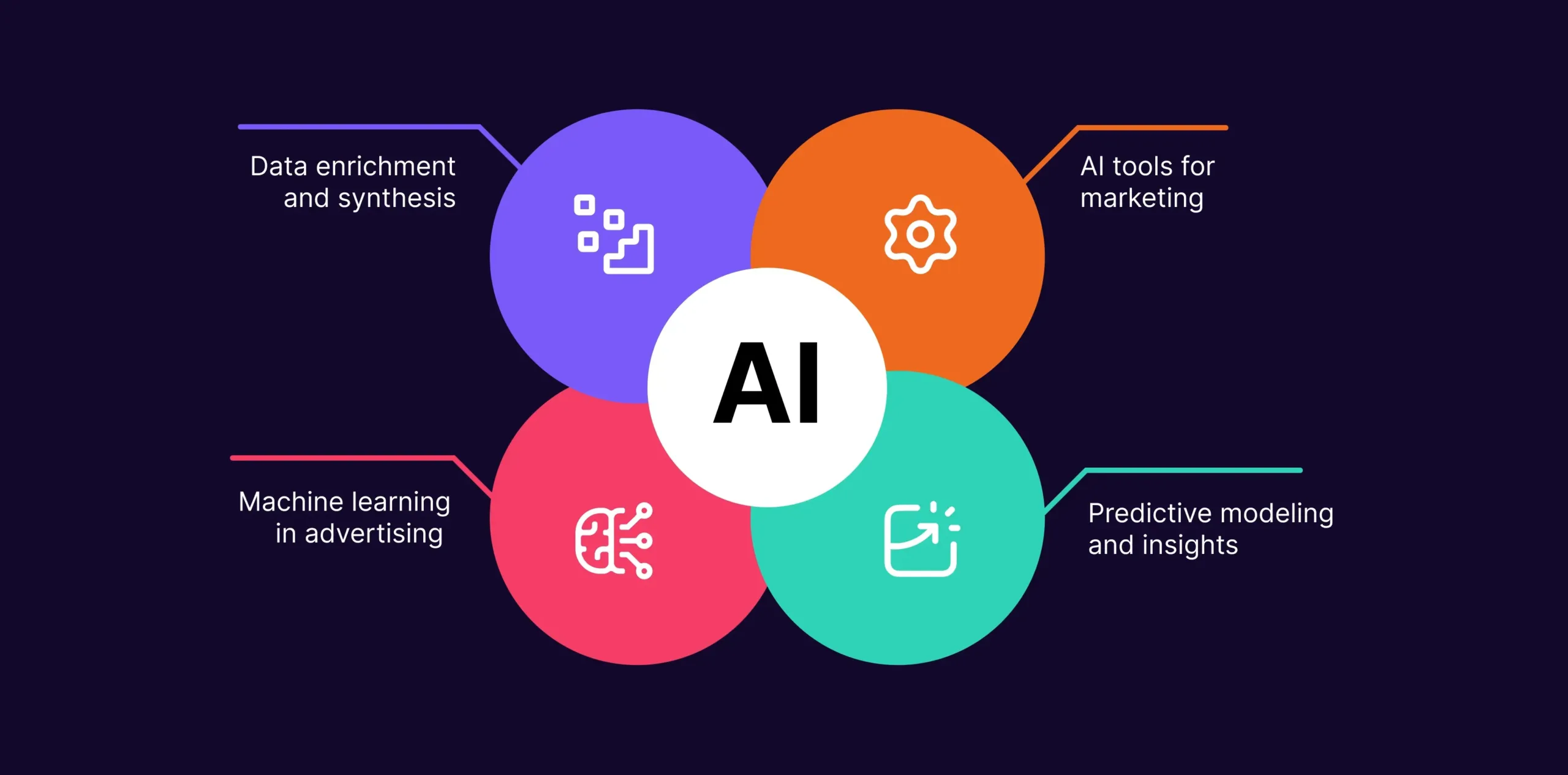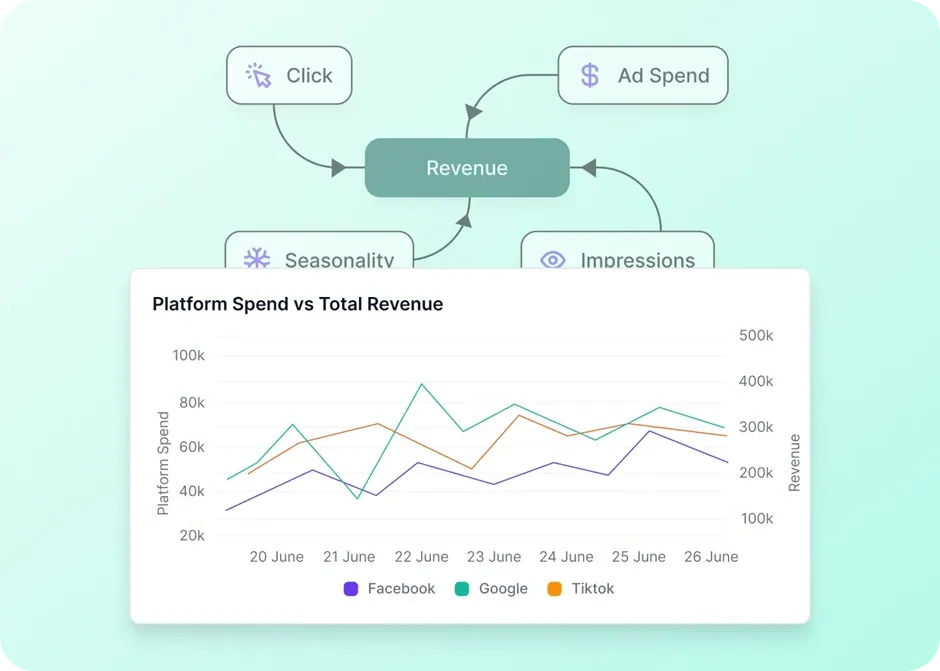Believe it or not, marketing has the most to gain from AI of all business functions.
AI in marketing enhances the core marketing activities for each stage of the customer’s purchasing journey – understanding your audience’s needs, matching them to products, personalizing campaigns and services, and converting leads to customers.
McKinsey’s research suggests that 90% of commercial leaders expect to use generative AI solutions over the next two years. Forward-thinking marketing leaders and CMOs are already considering (and implementing) AI to connect with and serve their customers.
Here, we outline the different ways in which AI is reshaping marketing and the suggestive path forward.
1) Data enrichment and synthesis to deliver the best first-party data to marketing channels
The State of Data Quality Survey, 2023, suggests that 25% or more of the company revenue is impacted due to poor data quality.
Use AI-based consumer data enrichment to improve data quality as AI-powered data platforms merge external and internal data sources to derive quality conclusions. They augment existing data sets and add more value to the data for better understanding and deeper analysis.
Modern marketers use data platforms leveraging data enrichment to get a 360-degree overview of customer needs, segment target audiences, and personalization.
Let’s understand these use cases with examples.
Suppose you’re running an eCommerce brand with omnichannel marketing strategies. You have rich 1st party data sources but cannot derive valuable insights that inform your marketing strategies and ad campaigns.
Use case 1: Using a first-party identity graph for enriched customer profiles
Leveraging a first-party identity graph significantly enhances the quality of first-party data available to marketing channels. This graph stores a user’s identifiers, such as names, contacts, and marketing identifiers like Facebook Pixel IDs and Google Click IDs.
It enriches these identities with external identifiers and links anonymous to known identifiers, enabling marketers to track anonymous customer profiles more effectively. This, in turn, improves match rates for ad channels, facilitating better-targeted retargeting campaigns and triggering more precise marketing automation flows.
Use case 2: Setting up CAPI
Incorporating a conversion API (CAPI) represents a transformative approach to managing conversion data. Unlike traditional client-side methods like web pixels, CAPI operates server-side, offering a direct channel to send event data from your servers to third-party advertising platforms.
This method not only enhances the flexibility and reliability of tracking conversions but also ensures complete ownership and control over the conversion data. Through CAPI, marketers can significantly improve the accuracy and efficiency of their ad targeting and measurement, leading to more effective marketing strategies.
Use case 3: Segment target audiences
Leverage data platforms to enrich data through real-time processing and segmentation based on the audience’s demography, behavior, geography, and preferences. Build segment-specific ad campaigns to target your audience in a personalized manner to improve user engagement and ad retargeting.
Use case 4: Hyper-personalize communications
Use data enrichment and synthesis to access real-world audience data points like preferences, dislikes, favorite social channels, and lifestyles. Personalize your communications based on these insights to build a special relationship with your audience and boost conversion rates.
Lifesight’s measure seamlessly integrates marketing, business, and customer data, enabling a more granular analysis. Lifesight offers,
- AI-generated segments to dive deeper into customer behavior and make informed marketing decisions
- Predictive behavior modeling to automatically predict customer behavior like LTV, purchases, churn rate, and more
2) AI tools for marketing content and creatives at scale
By now, you must’ve used generative AI marketing tools like ChatGPT, Bard, or Jasper to streamline content production, boost campaign creativity, and deliver personalized customer experiences.
According to Zara Kerwood, Senior Director of Creative Technology at George P. Johnson (UK and Nordics), ‘leveraging AI for marketing campaigns must not be about showing off the tech itself, but to enhance customer experiences.’
Here’s an example of how the American Marketing Association (AMA) used AI to create personalized newsletter content for improved customer experience.
- They created custom articles for each newsletter subscriber, merged their internal content featuring at the top, and individualized subject lines.
- The AMA team was able to save time on creating newsletter content and increase their send frequency simultaneously using AI.
The result?
- 42% monthly subscriber engagement rate
- AMA.org became the most clicked news source within the newsletter, significantly boosting website traffic.
Alongside this, another practical use case of AI is in creating unique and stunning creatives for ad campaigns.
A study by KANTAR on using AI creative testing to meet client demands suggests that premium-quality creatives can boost an ad campaign’s performance 12x, leading to a 30% increase in ROI.
As per Superside, using Midjourney image generation to replace traditional stock images in their client’s ads allowed the team to develop a unique style while moving fast and maintaining brand consistency.
The result was 70% design time saved to create 114 ad variations.
3) Machine learning in advertising
Advertisers are using machine learning products to save time and generate better results for ad campaigns. The two most popular products have been Google Performance Max and Meta’s Advantage+ Shopping campaigns.
The advantages of using Performance Max campaigns include:
- Improved performance: Machine learning optimizes ad delivery and targeting to help businesses achieve better results compared to managing campaigns manually.
- Efficient use of resources: They find the most effective combination of bids and targeting to meet your performance goals and get more value from your advertising spend.
- Simplified campaign management: As machine learning takes the guesswork out of campaign management to optimize delivery and targeting, you save time and resources that would otherwise be spent on manual optimization.
- Increased flexibility: You can use them for a variety of purposes including driving leads and sales or increasing website traffic.
- Create new assets at scale: Google AI generates new images and text assets for cross-channel campaign optimization.
- Enhance existing assets: Use AI-powered image editing in Google Ads to test your image variations, share previews of all assets, and simplify the creative review workflow for your teams.
According to a case study by Inflow, when KEH Camera consolidated its Smart Shopping Campaigns with Performance Max, the results outperformed its Smart Shopping Campaigns significantly.
In comparison to the first quarter of 2022 (Smart Shopping Campaigns), in the first quarter of 2023 (Pmax), KEH was able to achieve:
- 76.3% increase in ad revenue
- 44.1% increase in transactions
All automated ad products by Meta are unified under Meta Advantage. Meta released Advantage+ Shopping campaigns as a rival to Google’s Performance Max. Advantage+ Shopping campaigns use machine learning to help businesses reach their targeted audience more efficiently without lengthy setup time.
The benefits of using Meta’s Advantage+ Shopping campaigns are:
- Quick and easy setup
- Use machine learning to build agile and effective ad combinations
- Target new and current customers with personalized recommendations
- Automates/ combines all audiences, reducing overlapping
- Tests 150 creative combinations to determine the best-performing ad
Lifestyle brand Homesick ran Shops ads with Advantage+ Shopping campaigns on Instagram and Facebook. They saw an 18% decrease in cost per purchase and a 27% higher return on ad spend when selecting “website and shop” vs selecting “website” only.
4) Predictive modeling and insights to increase campaign effectiveness
Predictive modeling helps marketers keep up with the ever-evolving consumer and market trends and make informed marketing decisions and strategies.
Each model is tailored to predict a specific outcome such as the chances of success of a new product launch, the consumer’s likelihood to purchase, or the impact of a marketing campaign on ROI.
A case in point is how L’Oréal used predictive analytics (Google Marketing Platform and Google Cloud) to predict which customers are more likely to purchase offline (in stores). They then reached those customers with online advertising campaigns.
Before this, even though customers discovered and interacted with the brand digitally, the majority of sales occurred offline. This fragmented journey, which led to offline sales, made it challenging for L’Oréal to connect its digital marketing investment to the ROI.
With predictive modeling to analyze this data, they found that there’s a 14-day time lag between people visiting the L’Oréal website and going to the store to make the purchase. These insights helped them build a customized ML model to predict people who are likely to visit the store to purchase in the next two weeks.
Lifesight’s unified marketing measurement platform lets you measure the true causal impact of marketing with incrementality testing and Causal Marketing Mix Modeling (MMM).
- Design and run experiments with an incrementality testing suite
- Create optimal media plans with accurate forecasts and optimize marketing budgets with MMM
- Get a unified view of campaign performance, leverage data-driven attribution models on customer journeys
- Predict outcomes accurately and automatically identify the cause-and-effect relationship between influencing factors
platform-spend-vs-total-revenue
The Way Forward
When looking at introducing AI in marketing, we recommend the following four actions:
- Audit the commercial activities: Within your marketing department, explore how you could start implementing AI use cases. This decision could be based on the challenges your team faces.
- Build a cross-functional team: Form a commercial team (for example that includes data, marketing, and sales) to test the applicability of commercial use cases.
- Identify the low-hanging fruit: What are the low-cost, low-risk, and high-impact areas for application?
- Launch some AI experiments: Start with a few pilot use cases, track results, and refine the approach before broader implementation.
Lifesight is a unified marketing measurement platform that helps marketers make data-driven decisions using marketing mix modeling, incrementality testing, and causal AI. The three areas where you could start using AI and predictive modeling to supercharge your marketing performance are:
-
- Budget campaign optimization: Optimize your ad spend and campaigns on a granular level to reduce your cost-per-acquisition (CPA) and drive higher return on ad spend (ROAS) to drive business KPIs using budget optimization.
- Media planning and forecasting: Lifesight’s incrementality-powered media planning and forecasting tool helps you build optimal marketing scenarios without lengthy planning to maximize your ROI without the manual grunt work.
- Marketing impact assessment: Track the performance of your decisions on critical business KPIs and avoid wasted media spend through incrementality intelligence using marketing impact assessment.
To implement AI-powered marketing measurements, book a demo with Lifesight.
You may also like
Essential resources for your success

























































